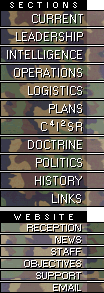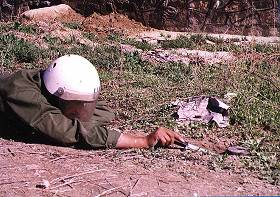





Landmine Danger Dropping Worldwide But Not in Afghanistan
December 27, 2001

he number of deaths caused by landmines and unexploded ordnance has fallen to less than 10,000 a year from the previously reported 26,000 casualties annually, according to a new U.S. State Department report.
The report, the third edition of "To Walk The Earth In Safety: The United States Commitment to Humanitarian Demining," also finds that the total number of landmines in the ground has dropped to 45 to 50 million in 60 countries, down from the initial assessment of 80 to 110 million landmines worldwide in 1999. It says the decline in the number of reported casualties could be attributed to efforts by the international community to focus on mine awareness education, greater clearance of mines and other unexploded ordnance, and on better reporting capabilities.
But in Afghanistan, the danger from landmines and unexploded ordnance is a daily threat. As Afghan civilians continue to flee their homes seeking refuge from the bombing in their country, the United Nations is warning that special care must be taken to avoid deadly landmines that litter the territory.
Speaking from Islamabad, Dan Kelly, manager of the UN Mine Action Programme for Afghanistan, said that the danger of existing minefields was compounded by the fact that the coalition bombing of military installations had struck some ammunition depots. "When these depots get hit, they spray all kinds of ordnance over a five kilometre (three mile) radius," he said, noting that some of the depots were in urban areas. "What is left on the ground unexploded is very dangerous and should not be touched."
The United Nations considers Afghanistan to be one of the most mine and unexploded ordnance affected countries in the world, with at least 732 million square metres of the country still mined.
In Kosovo, the landmine legacy of the 1999 conflict has been removed. The United Nations administered Yugoslav province has been cleared of all landmines, a Ljubljana based regional demining trust said November 23.
U.S. soldiers pass out specially designed comic books to children in Bosnia to warn them about the dangers of landmines. The International Trust Fund for Demining and Landmine Victims Assistance (ITF), that arrived in Kosovo three years ago, said it had cleared 4.7 million square meters (51 million square feet), removing 2,273 landmines and 1,221 other unexploded devices in the province. The demining of Kosovo was coordinated by the UN Mine Action Coordination Centre. The ITF is active also in Croatia, Bosnia, Macedonia and Albania.
Private non-profit groups are working alongside local communities around the world to remove landmines. The Mines Advisory Group (MAG) is a non-profit organization based in Manchester, England and Washington, DC with over 10 years experience in 20 countries responding to the problems caused by landmines and unexploded ordnance.
"Minefields are nothing like football pitches," MAG says on its new website: http://www.mag.org.uk/. "They are often in and around houses, orchards, schools, riverbeds, wells and hospital compounds. Minefields cover the sides of mountains, terraces and paddy fields. They ring fortified areas on hilltops. Pools and small lakes have to be drained and checked to ensure that no mines remain.
"Land like this has been fought over, it has been booby-trapped against an advancing enemy, and it has been mined to prevent an opposing faction from taking control. Far too often, mines have been used in such areas to prevent civilians from returning, or to control them," MAG says.
Sign warns of landmines in Angola In 1989, MAG began with the first survey of the impact of landmines in Afghanistan following the withdrawal of Soviet forces. The organization now runs projects in Angola, Azerbaijan, Cambodia, northern Iraq, Laos, Lebanon, Somaliland, southern Sudan, Vietnam and plans more projects through 2002. The U.S. State Department report the status of current country demining programs. Moldova declared itself mine safe in 2001, while Costa Rica, Guatemala, Namibia, and Rwanda are expected to declare themselves mine safe in 2002 and 2003, the report says.
"The United States first became involved in humanitarian demining in 1988 when it sent a team to assess the landmine situation in Afghanistan," says Lincoln Bloomfield, assistant secretary of state for political-military affairs and the special representative to the president and the secretary of state for mine action.
"By the end of 2001," says Bloomfield, "we will have provided more than $500 million to 38 countries, as well as the Province of Kosovo and northwest Somalia, for various humanitarian demining efforts such as deminer training, mine awareness and mine clearance, as well as orthopedic assistance to, and socioeconomic reintegration programs for, landmine accident survivors and their families."
Text source: ENS, December 6, 2001
© 2001 CheckPoint |














